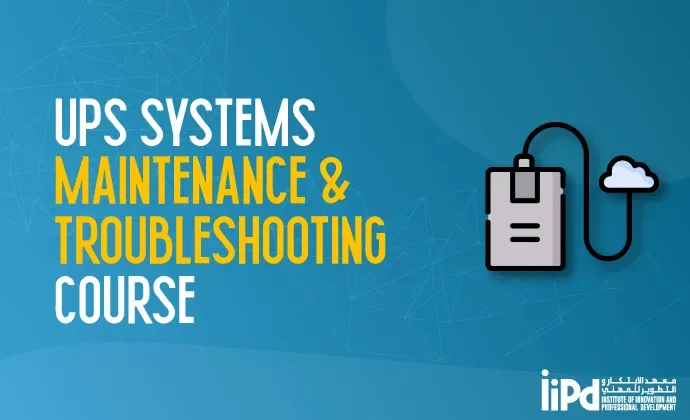
Course Details
Protect Your Critical Equipment from Power Outages
In today's digital world, safeguarding your equipment from power disruptions is crucial. This UPS training equips you with the expertise to ensure continuous operation.
This course equips you with the knowledge and skills to manage UPS systems effectively. You'll gain a thorough understanding of different UPS types, applications, and best practices for installation, maintenance, and troubleshooting.
What You'll Learn
- UPS Fundamentals: Explore core concepts like grid issues, UPS applications, and various UPS topologies (Offline, Line-Interactive, Online Double Conversion).
- Hands-on Training: Gain practical experience through simulated scenarios covering installation, configuration, maintenance, and troubleshooting common UPS issues.
- In-Depth Knowledge: Dive into advanced topics like battery selection, harmonic mitigation, and preventive maintenance procedures.
- Real-World Applications: Learn how to choose the right UPS for specific needs and ensure continuous power supply for your critical equipment.
Who Should Attend
This course benefits a wide range of professionals responsible for maintaining IT infrastructure:
- IT managers and technicians
- Electrical and mechanical engineers
- Data center personnel
- Network administrators
- Technical support staff
- Facility maintenance staff
- Anyone interested in UPS systems and their applications
Flexible Learning Options
The course is available in both classroom and virtual instructor-led formats (CILT & VILT) to fit your learning style and schedule.
Invest in Uptime and Equipment Protection
By enrolling in this comprehensive UPS training program, you'll gain the expertise to ensure your critical IT equipment's smooth operation and protection.
Course Outline
Below is the course content, which includes a detailed outline of topics and materials covered in the course. Explore and enhance your knowledge!
Day 1 - Introduction to UPS Systems, Application and Types
- What is UPS?
- Introduction to UPS Systems
- Type of Grid Issues
- Resilience, Resilient Power System
- Type of UPS systems
- Offline UPS
- Line Interactive UPS
- Double Conversion Online UPS
- Generator and ATS (with and w/o Bypass Isolation)
- Single Line Diagram of UPS System
- Introduction to Main Parts of UPS
- Principle Diagram
- How UPS does work?
- Description of UPS Operation
- Normal mode operation
- Battery Mode Operation
- Static By-Pass Mode Operation
- Manual Bypass Mode Operation
- UPS Applications
- UPS Types as per Applications
- UPS Selection as per Application
- Stand Alone UPS Configuration
- UPS Accessories and Options
- Input Isolation Transformer
- Rectifier Isolation Transformer
- Bypass Isolation Transformer
- Output Isolation Transformer
- Back Feed Protection
- Back up Time
- Parallel UPS System
- N+1 & N+2 UPS Systems and Their Operation
- Modular UPS systems
- How to Avoid Single Point of Failure
- Type of UPS (re-look)
- Power Electronic Elements & Applications
- Single Line Diagram of Each Part of UPS
- Harmonics
- UPS Project Single Line Diagram
- Quiz/Exercise Day 1
Day 2 - UPS specifications, DC UPS systems, Batteries and Harmonics
Below is the course content, which includes a detailed outline of topics and materials covered in the course. Explore and enhance your knowledge!
- Project Specifications and Compliance
- Galvanic Isolation
- Transformer-based UPS
- Transformer Less UPS
- Load Power Factor
- Type of Batteries
- Comparison of Different Types of Batteries
- Temperature, Heat Dissipation, Cooling for UPS & Batteries
- Common & Separate Batteries Bank
- UPS Communication with PCs, Data Centers, BMS, PLC, SCADA
- Service Bypass, Manual Bypass, and External Manual Bypass
- UPS Output Power Factor
- EMC, Topology, 3Ph or 3P+N UPS
- Input Isolation & output Isolation
- Grounding Systems
- UPS Selection and configuration
- Comparison Between Transformer Less & Transformer Based UPS
- Total Harmonics Distortion (Voltage & Current)
- Methods to Mitigate the Harmonics
- 6 Pulse Rectifier
- 12 Pulse or 18 Pulse Rectifier
- Pure Pulse or IGBT Based Rectifier
- Active & Passive Harmonic Filter
- Types of Energy Storage
- Batteries, Fuel Cell & Fly Wheel
- Types of Batteries and Their Comparison
- Battery Selection, UPS compatibility
- Run Time Calculation
- Batteries Monitoring System
- Introduction to the DC UPS system
- Rectifier, battery chargers specs and selection
- 24V, 48V, and 110VDC UPS systems with different types of batteries
- DC UPS batteries Sizing and configuration
- Operation of DC UPS system
- Quiz/Exercise Day 2
Day 3 - UPS Installation, Commissioning, O&M, Trouble Shooting
- BOM CheckList
- UPS Hazard
- Batteries Hazard
Safety Procedures Risk Assessment and Inspection Test Plan - Personal Protective Equipment
- Important checks before start work on AC UPS, DC UPS, and Batteries
- Installation Checklist UPS & Batteries
- Megger Test
- Batteries Installation, safety, and risk assessment
- Physical / Visual Inspection of different Parts of the UPS System and possible issues
- Pre-Commissioning of AC & DC UPS
- Rectifier Startup, Expected Test Results
- Investor Startup, Expected Test Results
- Batteries Connection to the UPS, Rectifier
- Static Bypass, Manual By-Pass, and Back Feed Protection Testing
- Preventive Maintenance Report
- Graphic display, software, and parameters
- Possible Problem in Rectifiers, troubleshooting
- Alarms and faults in the Investor section
- Parts (PCB, Fuses, Power Electronics, consumables) replacement
- Operation and Maintenance of UPS & Batteries
- Faults Diagnosis and Alarm
- Parameters and Calibration Method of UPS & Batteries
- Quiz/Exercise Day 3
Conclusion
This UPS training empowers you to become a confident and skilled professional in managing these essential power protection systems. Safeguard your business continuity and minimize downtime with a solid understanding of UPS technology.








